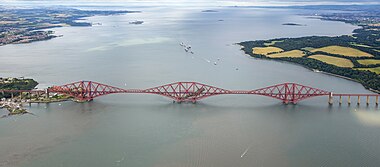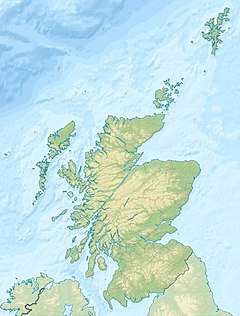Forth Bridge
| Forth Bridge | |
|---|---|
|
|
|
| Coordinates | 56°00′02″N 3°23′19″W / 56.000421°N 3.388726°WCoordinates: 56°00′02″N 3°23′19″W / 56.000421°N 3.388726°W |
| Carries | Rail traffic |
| Crosses | Firth of Forth |
| Locale | Edinburgh, Inchgarvie and Fife, Scotland |
| Maintained by | Balfour Beatty under contract to Network Rail |
| Characteristics | |
| Design | Cantilever bridge |
| Total length | 8,094 ft (2,467 m) |
| Width | 120 ft (37 m) at piers 32 ft (9.8 m) at centre |
| Height | 361 ft (110 m) above high water |
| Longest span | 2 of 1,700 feet (520 m) |
| Clearance below | 150 ft (46 m) to high water |
| History | |
| Designer | Sir John Fowler and Sir Benjamin Baker |
| Construction begin | 1882 |
| Construction end | 1890 |
| Opened | 4 March 1890 |
| Statistics | |
| Daily traffic | 190–200 trains per day |
| Official name | The Forth Bridge |
| Type | cultural |
| Criteria | i, iv |
| Designated | 2015 |
| Reference no. | 1485 |
The Forth Bridge is a cantilever railway bridge over the Firth of Forth in the east of Scotland, 9 miles (14 kilometres) west of Edinburgh City Centre. It is considered an iconic structure and a symbol of Scotland, and is a UNESCO World Heritage Site. It was designed by the English engineers Sir John Fowler and Sir Benjamin Baker.
Construction of the bridge began in 1882 and it was opened on 4 March 1890 by the Prince of Wales, the future Edward VII. The bridge spans the Forth between the villages of South Queensferry and North Queensferry and has a total length of 8,094 feet (2,467 m). It was the longest single cantilever bridge span in the world until 1917 when the Quebec Bridge in Canada was completed. It continues to be the world's second-longest single cantilever span.
The bridge and its associated railway infrastructure are owned by Network Rail Infrastructure Limited.
It is sometimes referred to as the Forth Rail Bridge to distinguish it from the Forth Road Bridge, though this has never been its official name.
Prior to the construction of the bridge, ferry boats were used to cross the Firth. In 1806, a pair of tunnels, one for each direction, was proposed, and in 1818 James Anderson produced a design for a three-span suspension bridge close to the site of the present one. Calling for approximately 2,500 tonnes (2,500 long tons; 2,800 short tons) of iron, Wilhelm Westhofen said of it "and this quantity [of iron] distributed over the length would have given it a very light and slender appearance, so light indeed that on a dull day it would hardly have been visible, and after a heavy gale probably no longer to be seen on a clear day either."
...
Wikipedia


